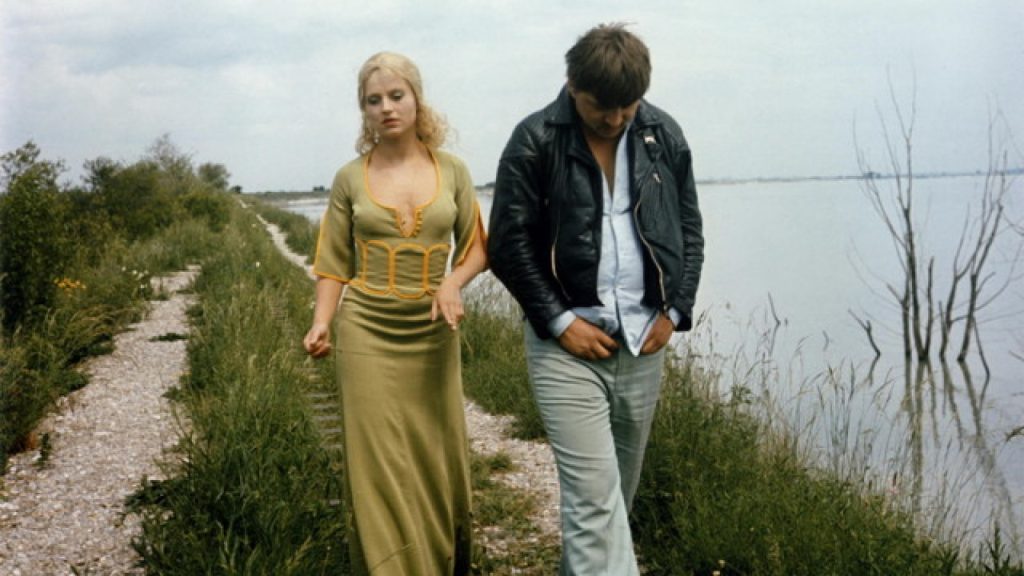As is often observed, Rainer Werner Fassbinder’s filmography, consisting of forty feature films, makes it difficult to critically appraise all of his films. Many times films are either over looked or simply ignored. Such is the case with The Niklashausen Journey, Fassbinder’s unexpected follow-up to Whity (1970).
The Niklashausen Journey is Fassbinder’s first overtly political film, and would remain as such until 1975’s Mother Kusters Goes To Heaven. The Niklashausen Journey follows the story of Hans Bohm, a shepherd in Bavaria during the fifteenth century, who believes the Virgin Mary has directed him to lead an uprising against the state and church to grant an equal disbursement of land and goods to the common people. After amassing a legion of followers, Bohm’s movement is subdued by the army of the Arch Bishop.

The Niklashausen Journey was released in West Germany in 1970 as a result of a commission by the WDR television network and broadcast by ARD television. The film was co-directed by Rainer Werner Fassbinder and Michael Fengler. Earlier that same year Fassbinder and Fengler had both co-directed the film Why Does Herr R. Run Amok? from a script by Fassbinder. Over the following decade Fengler would work as Fassbinder’s producer, most notably on the films The Bitter Tears Of Petra von Kant (1972), Shadow Of Angels (1976), Chinese Roulette (1978) and The Marriage Of Maria Braun (1979).
Like Why Does Herr R. Run Amok?, The Niklashausen Journey was a low budget film that utilized Fassbinder’s creative team from his Anti Theater. However, the narrative of The Niklashausen Journey did not cater to budget restraints as Fassbinder’s preceding films did. This made it a necessity for Fassbinder and Fengler to adopt an approach to the cinema whose self-awareness was derivative of Jean-Luc Godard’s early low budget features of the sixties. The Niklashausen Journey consists of only about a dozen or so scenes, most of which are either very theatrical tableauxs where there is no movement of the characters and the camera darts from speaker to speaker or are shots where characters pace back and forth speaking as the camera tracks the speaker (this latter camera move is more closely related to Bunuel’s films than to Godard’s). This particular mode of visual storytelling constantly reinforces the fact that the images seen are an illusion, drawing the audience’s attention to the mechanisms of filmmaking. Fassbinder and Fengler would barrow another concept from Godard, more specifically from Godard’s masterpiece Weekend (1968). What Fassbinder and Fengler saw in Godard’s film that they found useful was the appropriation of period costumes mixed with contemporary costumes and settings, allowing the narrative of their film to transcend its fifteenth century roots and find a political urgency in the film’s contemporary environment.
The political ideas of The Niklashausen Journey are distinctly Marxist, equating Hans Bohm’s spiritual revolution to not only the student demonstrations of 1968 but also to the Marxist radicalism at play in the struggle for power between the United States and Russia in South East Asia and the Middle East. But the political dialogue of the film is not restricted to Marxism, Fassbinder’s script opens up further debate and contemplation by imbuing each of Bohm’s followers with political agendas as diverse as Black Power, Socialism, Theological reformation and anarchy. The diverse nature of political radicalism represented in the film works to equate all radicalism to one principal idea of political revolution and the necessity for rebellion, a philosophical thesis similar to that which Albert Camus puts forth in his book The Rebel.
The heightened degree to which Fassbinder and Fengler take their cinematic concepts pushes the film beyond Weekend or any other immediate influence. In essence the film reinvents the visual vernacular of avant-garde political filmmaking simply by the nature to which the genre’s mechanisms are exaggerated.
